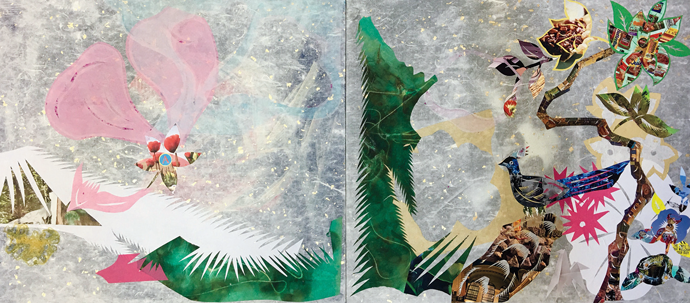
Life in Full Bloom Series 03, collage on wood panel, by Song Xin © The artist. Courtesy Chambers Fine Art, New York City
Migrant women who have recently settled in Australia and Canada understand menopause both as an “Age of Despair” and “When Life Starts.” Extreme weight-loss behaviors are equally prevalent among US inner-city adolescents of all races but are most extreme among girls who have been abused and feel hopeless. A psychologist described the clinical features of death from give-up-itis and warned that the vestiges of goal-directed behavior displayed by the afflicted shortly before death are directed toward the goal of ceasing to live. Chinese adolescents who are sleepy in the daytime are likelier to try to kill themselves. A study of Norwegian men who had attempted suicide distinguished between two intentions: “to die” and “not to die.” Danish medical researchers examined the “existential strength” of significant others preparing for the return of their partners from the hospital. Israeli gerontologists examined the factors that contribute to elderly Jews’ will to live, and people afflicted with locked-in syndrome have a stronger will to live than others assume. Doctors in Spanish-speaking countries tested a translated version of the Demoralization Scale. Apathy is highly consistent in patients with young-onset dementia. Periodontitis was associated with mild depression in Brazilians.
Ravens may be able to plan without thinking, and jackdaws act cautiously when they notice an inanimate stick moving on its own. Rats will rescue trapped robots and prefer social interaction to narcotics. Dogs possess known unknowns. The majority of adult cockroaches, but no immature cockroaches, can defend against emerald jewel wasps’ attempts to turn them into zombies. Cave fish are left with permanent scars when their hearts are damaged, whereas their surface-dwelling cousins’ hearts can regenerate. Many European cave paintings that appear to represent animals actually depict constellations. Planetary astrobiologists who observed a rare rainfall in the Atacama Desert discovered that it killed off what little life had persisted there. Humans may not have been responsible for the extinction of African megafauna. The closest remaining genetic trace of the domesticated dog that lived in the Americas before European contact is preserved as a transmissible cancer. The museum collections of the University of Helsinki were confirmed to include a bastard seal. Fluid-dynamics researchers explained why wombats’ feces are cubed.
Chinese state media reported a plan to put an artificial moon into orbit. Scientists issued extinction warnings for thousands of species, including sharks and rays threatened by overfishing and coastal construction; the Australian rat kangaroo, threatened by land clearing, wildfires, and feral cats; the San Quintín kangaroo rat, threatened by conditions that previously led scientists to presume it was already extinct; a giant Mediterranean clam threatened by a mystery parasite; and a variety of rare bees threatened by Donald Trump. Australian officials were determining their conservation priorities, in part, on the basis of whether certain animals are “iconic.” Waste from invasive Asian jumping earthworms was contaminating US soil, climate change will make oysters less nutritious, and the Deepwater Horizon spill was found to have ruined stingrays’ sense of smell. Higher pollen counts are linked to decreases in violent crime, whereas warmer winters contribute to an increase in crime rates. A warm room makes people likelier to say yes. An incendiary gender-reveal event planned by a US Border Patrol agent was revealed to have caused a massive Arizona wildfire. Intense wildfires were releasing additional CO2, exacerbating the warming cycle, and CO2 levels were higher than they have been in at least 3 million years. Sometimes the commons are not tragic, but most of the time they are.




